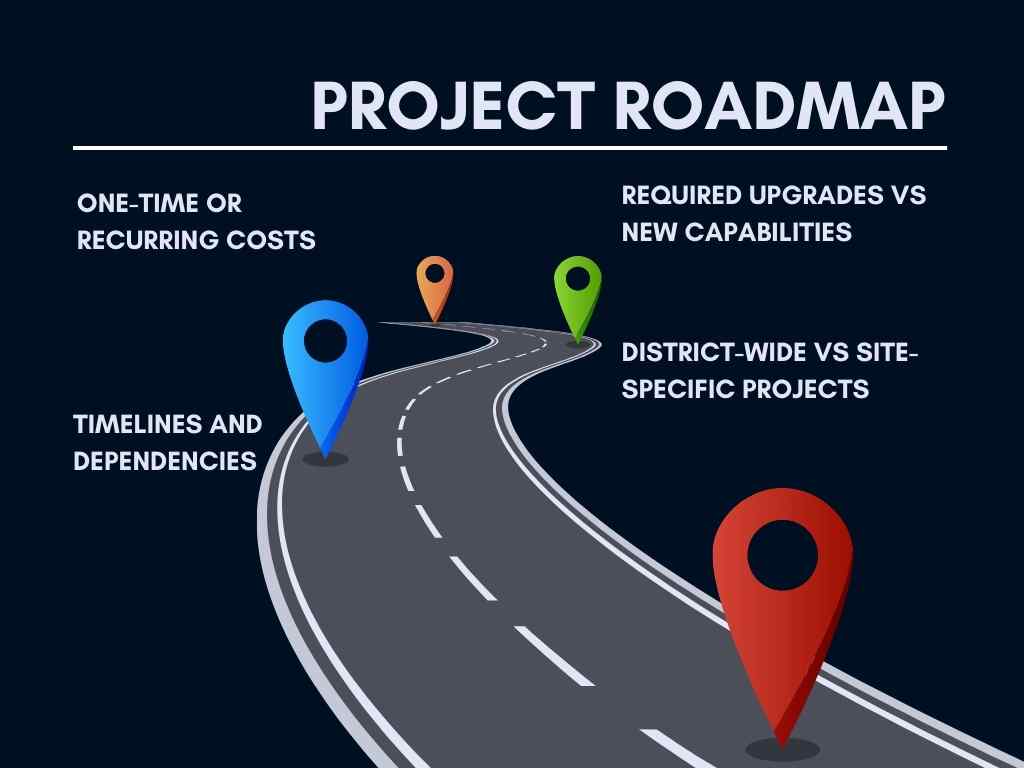Developing a long-term technology plan is an essential strategic initiative for K-12 schools and districts aiming to prepare students for our increasingly digital world. With robust planning, administrators can implement education technology to enrich instruction, empower new models of teaching and learning, and equip children with future-ready skills.
Yet for many school and district leaders, the technology planning process itself represents a formidable challenge. Where do you start? How do you craft a comprehensive execution roadmap across years? What funding models work best? Without clear direction, it’s tempting for shiny gadgets and software to sit collecting dust, failing to deliver real value.
This detailed guide examines the key phases of designing a tailored education technology plan for your unique learning community. With expert guidance and some concerted upfront effort, your schools can make the most of IT investments.
Table of Contents
Align Tech Goals With Your Overall Education Plan
The foundation for successful technology planning starts with linking IT objectives firmly to student learning goals and your existing strategic plan. Doing so prevents tech from becoming siloed in its own bubble, disconnected from real curriculum needs.
Begin by clearly defining how proposed infrastructure upgrades, new devices, or software platforms will enrich instruction to further core competencies. Ask questions like:
- How will this technology aid our broader mission to educate and fully prepare students?
- What specific skills or learning outcomes does this target across various grade levels?
- Who will utilize the tech and for what kinds of teaching/learning activities?
Understanding the “why” behind technology investments guides intelligent procurement aligned tightly to instructional goals. This alignment lets you demonstrate value and make cohesive arguments to governing groups regarding budget tradeoffs.
Conduct An Analysis As Existing Infrastructure
An accurate gap analysis between current-state infrastructure and an ideal future-state environment clarifies exactly where attention and dollars must be focused. Key areas for in-depth as-is review include:
- Campus Connectivity: Audit wifi access points, cabling, network switches/routers supporting LAN/WAN connectivity.
- End-User Hardware: Review quantity, age and condition of teacher and student devices like laptops, tablets and classroom tech.
- Core Infrastructure: Assess centralized data center capacity, speeds and age of servers, storage systems and backups.
- Enterprise Platforms: Evaluate critical systems for email, learning apps, student information systems, and network security controls.
- Service Quality: Capture qualitative feedback on IT support responsiveness, user experience and satisfaction.
This analysis should gather quantitative specs on equipment age, warranties and performance benchmarks. It can be performed internally if existing IT leadership possesses the bandwidth and institutional knowledge. Alternatively, engaging unbiased external specialists brings fresh perspective to identify unseen gaps or risks. They can also provide comparative data on peer institutions.
Map The Multi-Year Project Roadmap

With vision aligned to outcomes and current-state analysis completed, the real planning begins by defining discrete projects then sequencing rollout over 2-5 years.
Initiatives should be categorized by criteria like:
- Timelines and dependencies
- One-time or recurring costs
- District-wide vs site-specific projects
- Required upgrades vs new capabilities
Logical sequencing is critical. For example, refresh underlying network infrastructure first before deploying bandwidth-intensive 1:1 student device programs. Phase longer term projects into modular phases to deliver value without overextending focus or budgets.
The roadmap will adjust but serves as the guiding force for annual plan creation and budgeting cycles. It should reflect consensus among district and school decision-makers to support coordinated implementation.
Create Realistic Budgets and Funding Plans

Even superb technology plans go sideways without stable funding. Constructing detailed budgets and pursuing creative funding is vital.
For every project, tally costs like:
- New equipment or infrastructure
- Software licensing
- Professional/managed services
- Internal labor requirements
- Training and change management
Also budget for ongoing management of technology environments, rather than assuming one-off upgrades are the finish line. This includes costs for:
- Monitoring, maintenance and continual optimization
- Regular hardware/software refresh cycles
- Adding specialized IT headcount as portfolios grow
- Evolving IT security and regulatory compliance
Explore all financing sources, including bonds, municipal funds reallocation, grants, parent/community donations, or partnerships. Build contingencies for unexpected expenses or delays as cushion.
Engage Trusted Managed Services Partners
Few schools can tackle expanding technology solo anymore. The pace of change has outpaced internal-only models.
Managed Service Providers (MSPs) fill expertise, resource and support gaps through delivered as ongoing services. Ideal education MSPs provide:
- Skilled technical resources
- Tailored best practice blueprints
- Objective vendor-neutral guidance
- 24/7 performance monitoring
- Procurement efficiency
- Preventative maintenance
Seeking MSPs with dedicated K-12 practices ensures deeper understanding of unique district environments, tight budgets and complicated decision dynamics.
Vet thoroughly, check references on active school engagements, and validate ability to scale to your size. Like any partnership, continual communication ensures smooth planning and rollout.
Build In Measurement Mechanisms
The best technology plans recognize change is continual, not a single project.
Embed mechanisms to regularly evaluate progress against desired outcomes and KPIs. Be equally diligent about identifying new gaps or needs before they become setbacks.
Revisit analysis and planning every 2-3 years. While tactical adjustments happen incrementally, comprehensive reviews ensure you stay ahead of the curve. They also facilitate requesting added funding from community stakeholders or budget authorities.
Conclusion
Developing a comprehensive education technology plan with expert guidance is time intensively upfront. But schools who invest this effort are far better positioned to enhance instruction and equip students for the increasingly digital world. They also minimize missteps from adopting new gadgets without purpose.
FAQs
Experts recommend 3-5 year technology plans to balance providing direction while retaining flexibility. This allows time to execute larger initiatives while still updating the plan as needs shift.
Technology plans don’t require exhaustive specifications but should define core elements like budget estimates, timelines, decision-making processes, and success metrics. Too little detail risks losing stakeholder alignment. Too much bogs down progress.
Focus communication on direct student benefits like more personalized instruction, simplified access to learning resources, or workforce skill development. Bring user groups in early to tailor solutions to their needs and ease adoption fears.
Take an incremental approach by prioritizing foundational infrastructure like networks and security first. Then fundraise for incremental enhancements over time like device refresh programs. Managed services partnerships can also stretch budgets further.
Industry metrics indicate K-12 school districts spend 3-5% of total budgets on technology. However, investments should align to your district’s specific IT vision and gaps – whether requiring higher upfront costs or sustained commitments.
Form a core working committee with diverse district and school stakeholders like IT leaders, admin, teachers and finance heads. Co-develop the plan so all groups support coordinated execution.

